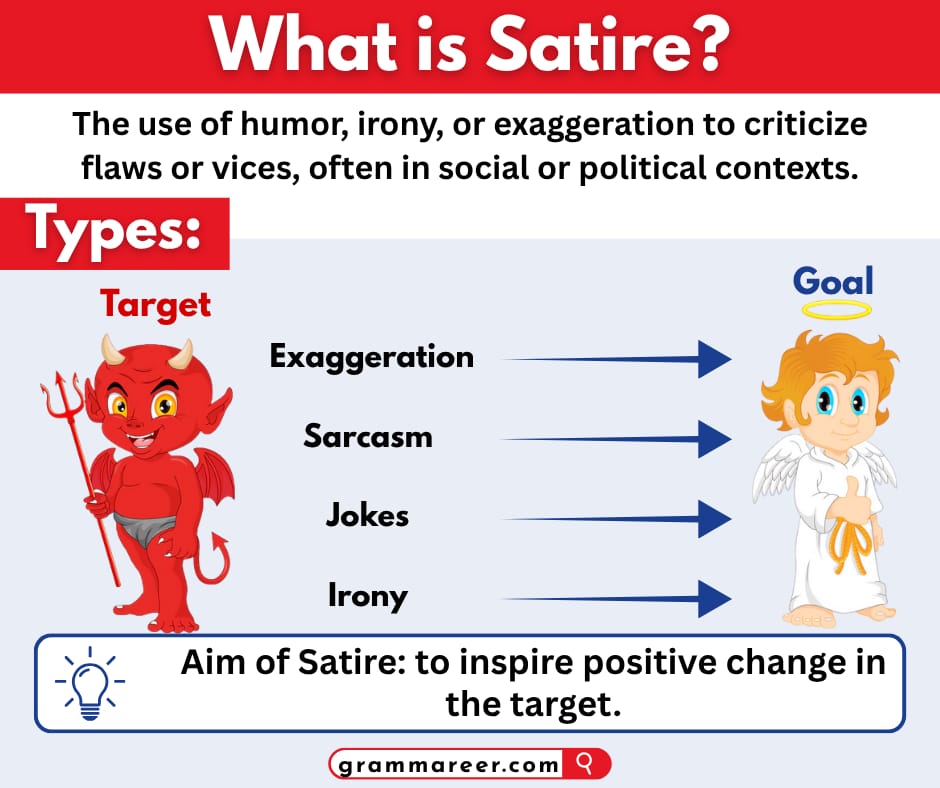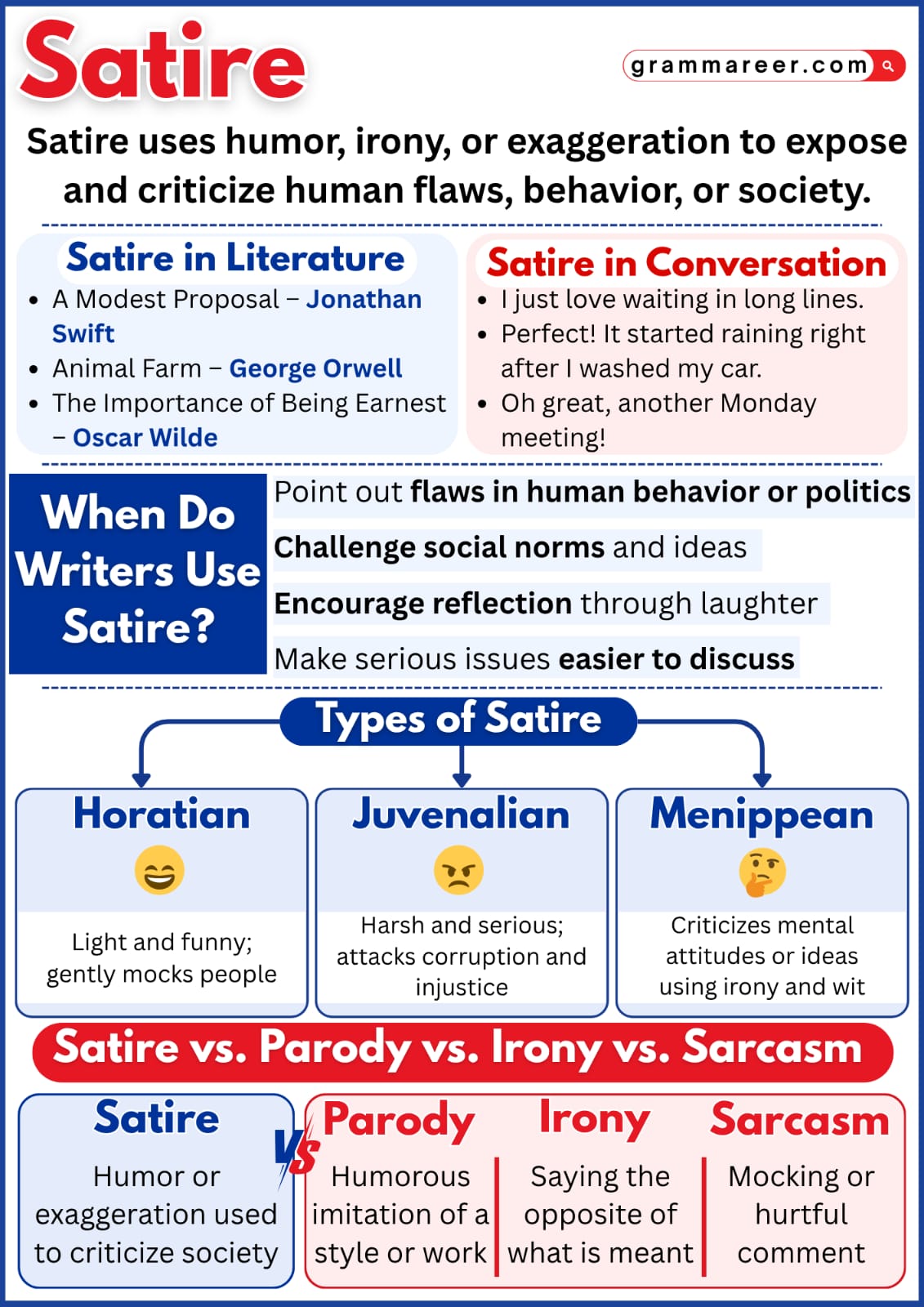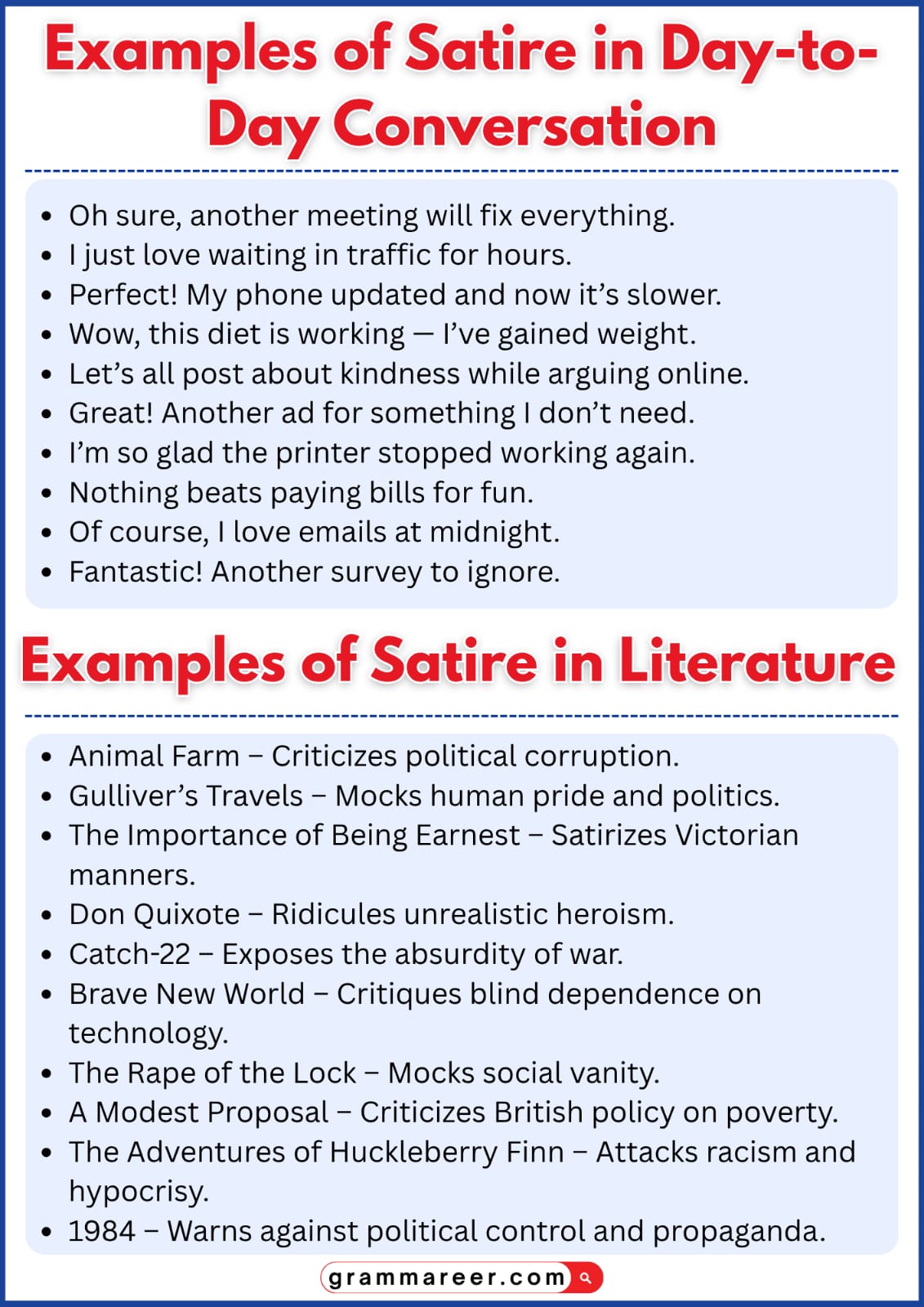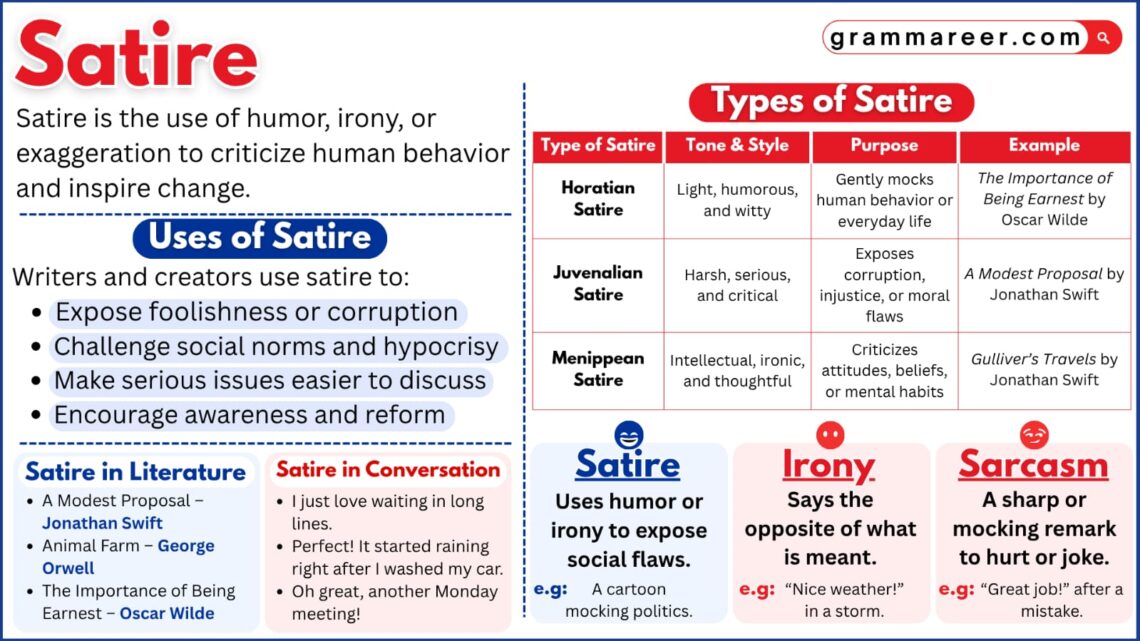Satire is a clever way of using humor, irony, or exaggeration to point out the flaws in people, politics, or society. It makes us laugh but also helps us think about serious issues that need attention. You can find satire in movies, books, TV shows, and even memes beacsue it is everywhere!
In this article, we’ll learn what satire really means, how it works, and see some interesting examples to understand it better.
Table of Contents
What is Satire?
Satire is a smart and funny way to point out the problems in people, politics, or society. Instead of being direct, it uses humor and creativity to make us think and reflect.
Writers often use tools like irony to show contrast, exaggeration to make flaws stand out, and parody to humorously imitate someone or something. Sometimes they use understatement or even sharp criticism to make their message stronger.
For Example:
- In Animal Farm, pigs act like humans to show how power can corrupt.
- A cartoon showing people worshiping their smartphones — making fun of our tech addiction.
- In The Daily Show, politicians’ promises are exaggerated to show how unrealistic they are.
- A meme saying, “Breaking News: Honesty Found Dead in Politics!” — humor used to criticize dishonesty.
Satire Definition
Satire is a smart and humorous way of pointing out people’s mistakes, bad habits, or flaws in society. It makes fun of things like corruption, foolishness, and hypocrisy for not just to entertain but to make people think and bring change.
Satire has been around for centuries. Even in ancient times, writers and poets used humor and exaggeration to speak the truth in a clever way. The word satire actually comes from the Latin word satura, which means “mixed” just like how satire mixes humor with criticism.

Types of Satire
Satire comes in different styles, each with its own way of criticizing people or society. The three main types are Horatian, Juvenalian, and Menippean. These all named after ancient writers who used humor to share serious messages.
| Type of Satire | Definition | Modern E xample |
|---|---|---|
| Horatian Satire | This type is light and funny. It gently makes fun of human mistakes or social problems to make people laugh and think at the same time. | • Shows like The Simpsons or Brooklyn Nine-Nine use humor to comment on everyday life and society. |
| Juvenalian Satire | This one is sharper and more serious. It boldly criticizes corruption, greed, and injustice to make a strong point. | • Black Mirror and Don’t Look Up show how technology and power can harm society. |
| Menippean Satire | This type mixes humor, philosophy, and storytelling. It targets wrong ways of thinking or strange beliefs instead of specific people. | • Fight Club and The Good Place explore human behavior and modern values in creative, thought-provoking ways. |
Each type of satire uses a different tone from playful to harsh but all aim to open our eyes to the truth behind society’s flaws.

How to Write Satire?
Writing satire is all about mixing humor with truth. It helps you talk about real issues in a funny, smart, and meaningful way. Here’s how you can do it easily:
1. Pick a strong topic:
Start with something people care about and it could be politics, social media, or daily life problems. A relatable topic makes your satire more engaging.
2. Decide what you’re mocking:
Be clear about what or who you’re criticizing, not to insult, but to make a point. Your goal is to expose the truth behind the humor.
3. Add humor wisely:
You don’t need to be over-the-top funny. Even a calm, clever tone can make your message stand out. The trick is to make people smile and think.
4. Use satirical tools:
- Exaggeration: Blow small issues out of proportion to show how silly they are.
- Irony: Say the opposite of what you mean to highlight the truth.
- Contrast: Place two very different ideas together to make the point clear.
- Absurdity: Create an unreal or funny situation that reflects real life.
In short, good satire entertains people first and then quietly makes them question what’s really happening around them.
Using Satire
Satire is a creative way to talk about serious issues while keeping people interested. It can make readers laugh, think, and even question what’s happening around them. But to use satire effectively, you need to know when it fits and when it doesn’t.
When to Use Satire
Use satire when you truly care about a topic and want people to notice it. It works best when:
- You’re passionate about the issue and want to express your opinion in a clever, engaging way.
- The topic is current — something people are already talking about or experiencing.
- You’re challenging those in power, not mocking ordinary or vulnerable people.
- You know your audience and understand their sense of humor and perspective.
When Not to Use Satire
Sometimes, satire can go wrong or feel insensitive. Avoid using it when:
- People might take it literally and miss the joke completely.
- It targets someone weak or struggling, as that can come off as cruel instead of clever.
- The topic is too painful or sensitive, like personal loss or a recent tragedy. In such cases, humor can hurt more than help.
Satire vs Irony
Let’s understand the difference: irony makes you laugh at the twist, while satire uses that twist to highlight real-life problems.
| Satire | Irony |
| Irony is when something happens that’s opposite of what you expect it’s used to make people laugh or think. | Satire, on the other hand, uses irony, humor, or exaggeration to point out what’s wrong in society and encourage change. |
| Example of Irony: • A fire station burns down. • A traffic cop gets his license suspended for unpaid parking tickets. • You post “I love Mondays!” after a rough start to your week. | Example of Satire: • Animal Farm by George Orwell : criticizes political corruption. • The Daily Show: uses humor to point out problems in politics. • A cartoon showing people glued to their phones while ignoring real life : mocks society’s obsession with technology. |
Examples of Satire in Literature
- Animal Farm – Criticizes political corruption.
- Gulliver’s Travels – Mocks human pride and politics.
- The Importance of Being Earnest – Satirizes Victorian manners.
- Don Quixote – Ridicules unrealistic heroism.
- Catch-22 – Exposes the absurdity of war.
- Brave New World – Critiques blind dependence on technology.
- The Rape of the Lock – Mocks social vanity.
- A Modest Proposal – Criticizes British policy on poverty.
- The Adventures of Huckleberry Finn – Attacks racism and hypocrisy.
- 1984 – Warns against political control and propaganda.
Examples of Satire in Day-to-Day Conversation
- Oh sure, another meeting will fix everything.
- I just love waiting in traffic for hours.
- Perfect! My phone updated and now it’s slower.
- Wow, this diet is working – I’ve gained weight.
- Let’s all post about kindness while arguing online.
- Great! Another ad for something I don’t need.
- I’m so glad the printer stopped working again.
- Nothing beats paying bills for fun.
- Of course, I love emails at midnight.
- Fantastic! Another survey to ignore.

Why Satire Matters?
Have you ever laughed at a joke and then thought, “Wait… that’s actually true”? That’s what satire does. It hides truth behind humor.
There’s a famous quote by George Bernard Shaw that says, When something is funny, look for the hidden truth inside it. That’s exactly the magic of satire. it makes you laugh, but it also makes you think.
Satire works because it lets people discover the truth on their own. When you make people laugh at something wrong or foolish, they start to see the problem themselves. That’s much more powerful than just shouting or blaming someone directly.
FAQs
Satire is a way of using humor, irony, or exaggeration to point out problems in people, politics, or society. It’s not just about being funny. it’s about making people think.
To spot satire, look for clues like:
• The use of humor or irony to make a point
• Exaggeration that makes situations seem silly or extreme
• A hidden message that criticizes something wrong in society
If the piece makes you laugh and think at the same time—it’s probably satire!
Some famous works that use satire include:
• Gulliver’s Travels by Jonathan Swift
• Animal Farm by George Orwell
• Utopia by Thomas More
• The Importance of Being Earnest by Oscar Wilde
• Candide by Voltaire
Each of these writers used humor and irony to expose flaws in society or human behavior.
You May Also Like




